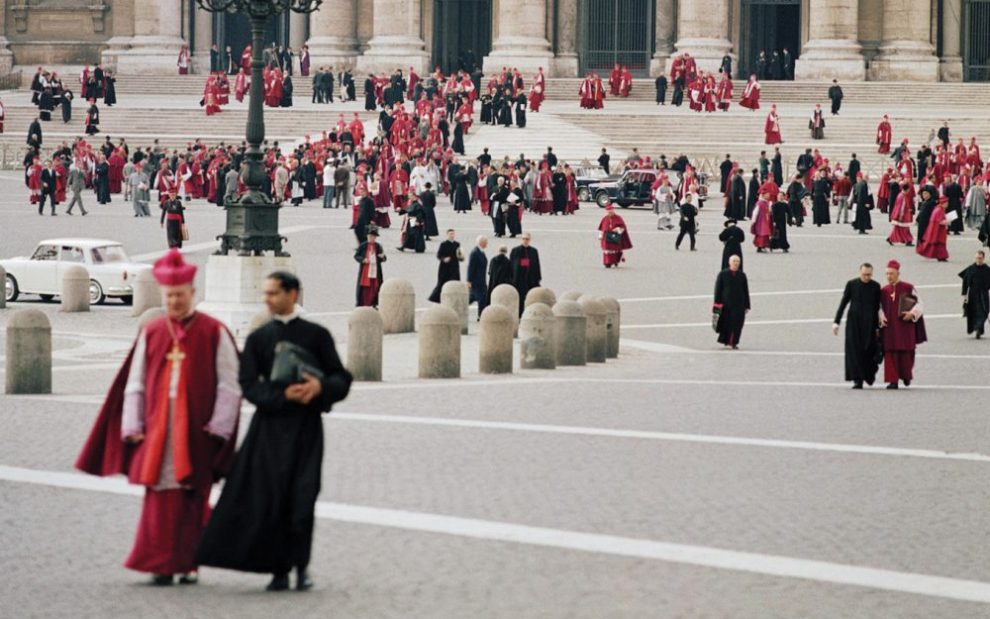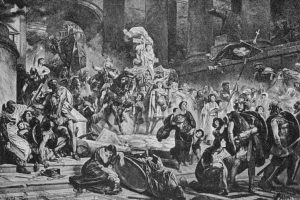Sometimes, we feel caught in a maelstrom. Modern life moves at a breathless pace and we despair at keeping up. Pope Francis dubbed this dizzying trajectory rapidification. Whether it’s fierce weather patterns, political spins, cultural zigzags, or international crises, the onslaught of unwelcome surprises is staggering. Add medical emergencies; unanticipated family developments; or the sudden loss of a job, home, or ability, and we can be forgiven for those hours when we resolve to abstain from participation in the madness.
I recently lost a parish that was meaningful to me. If you’ve personally experienced church closures or institutional upheavals, you know how unsettling and grief-producing such a loss can be. I went through pretty typical stages of loss: denial, anger, grief. The final one, acceptance, came slow and hard. As I cycled through emotional whirlwinds, I found myself withdrawing from the thought of surrendering to a new community. I don’t want to love new people, I reckoned. I want the ones already in my heart.
Cocooning for a time after upsetting new information makes sense. We absorb change in small doses, heal in layers from mind to heart to body to spirit. Cocooning protects us while we prepare for the required transformation. Retreat centers are there for a reason, after all. Sometimes the only way to move forward is to spend a period in retreat.
Maybe that’s why the longest and weightiest constitution from the Second Vatican Council is also the last one: Gaudium et Spes, otherwise known as the “Pastoral Constitution on the Church in the Modern World.” Translating as “joy and hope,” Gaudium et Spes offers the kind of joy and hope we can only take up after we’ve processed our disappointment at the passing of old ways.
Before composing Gaudium et Spes, the council members rearticulated what it means to be church in Lumen Gentium, called for liturgical renewal in Sacrosanctum Consilium, and summoned us to a deeper appreciation of our sacred story in Dei Verbum. Now it was time to open not just the windows of the church in aggiornamento but the doors themselves to the wider world.
Needless to say, some church leaders and churchgoers were still struggling with the notion that change was needed, or even plausible, in a religious institution that hadn’t admitted a hint of the different in conscious memory. “Why are we doing this?” was a familiar lament in my home parish back in the 1960s. Since none of us in the pews were reading these conciliar documents at the time, we appreciated none of the backstory of an institution coming out of a 400-year cocoon donned in self-protection after the assault of the Protestant Reformation. My pastor, I’m quite sure, understood the “changes” as little as we did in the back row. The poor man was ill-equipped to reassure us that any immediate loss would be the world’s gain.
“The Pastoral Constitution on the Church in the Modern World” was the final manifesto of Vatican II, and it remains a gem of a document. It arrived in 1965 as a capstone to what Vatican II hoped to achieve in throwing open the church’s windows to more light and fresh inspiration.
In Gaudium et Spes, the church demonstrates the audacity of an ancient institution poised to engage the “theater of history.” Human history is full of triumph and tragedy, wonder and anxiety, it declares. Humanity has and will accomplish much on its dizzying treadmill of progress; yet it could use a companion to offer moral guidance for its journey into the future. The church proposes itself as that companion for the human race.
Imagine! The world had stood outside the high fortress walls of Roman Catholicism for long centuries and was now being offered a hand in partnership. You will do great things, the church was saying to the global community at large, and we would like to help shape the compass of values that leads you forward into that marvelous land of the future.
A formerly forbidding and unwelcoming church was issuing an invitation to the world community accustomed only to its judgment and mistrust. “Inspired by no earthly ambition, the Church seeks but a solitary goal: to carry forward the work of Christ under the lead of the befriending Spirit,” reads the beginning paragraphs of the document. Rapid advancements in technology, the stockpiling of military arms, the jockeying of political systems for dominance, and an inexorably interdependent global economy were making it necessary for people of good will to contemplate what these powerful forces might do if left to the winds of ambition, greed, and self-interest. When the stakes are this high, wouldn’t a moral mentor be desirable?
“The destiny of the human community has become all of a piece, where once the various groups of men had a kind of private history of their own,” Gaudium et Spes keenly observes. Translation: Say goodbye to the private life or the exclusively parochial concern. Like it or not, we’re obliged to pay attention to the currents brewing around us—not just in the neighborhood, but around the globe. Cocoon as we will, stick our heads in the sand for a time, still social reality intrudes and influences us with its urgent demands.
Clashing ideologies will rage and hostilities flare in this unfolding future that locks the nations together more tightly than ever. Gaudium et Spes warns that our leaders, dependent on public opinion to secure their authority, may trade the common good for the culture wars as “feelings of hostility, contempt and distrust, as well as racial hatred and unbending ideologies, continue to divide men and place them in opposing camps.”
And who will win the prize of destiny in the ultimate ideology war? “[T]he future of humanity lies in the hands of those who are strong enough to provide coming generations with reasons for living and hoping,” Gaudium et Spes asserts. We come back to that word again: hope. Those who give us reason for joy and hope—gaudium and spes—are the ones we’ll follow. And this remains true from the land of politics to the realm of commercial advertising.
Promises of joy and hope don’t always come true, however. The truth can be so well spun by professional storytellers that it becomes a fabric of lies. Yet you and I are so needy for joy and hope that, the wilder rapidification becomes and the deeper the confusion wrought by change, the more we seek and surrender to anyone who promises to lead us back to a place of security.
So we double down on some eternal truths. People are more precious for what they are than for what they have. Culture needs guidance to develop a “religious, moral, and social sense.” And perhaps the most quoted idea from this constitution: Peace is more than the absence of war.
Cocooning in self-protection as we rest from the often-unsettling forces of our days can be a good thing. The blooming, buzzing confusion of our present world will still be waiting for us when we get back. Maybe Gaudium et Spes will even inspire us as we rejoin the fray. Because our big beautiful world could use a church that seeks its friendship.
This article also appears in the August 2024 issue of U.S. Catholic (Vol. 89, No. 8, pages 47-49). Click here to subscribe to the magazine.
Image: Lothar Wolleh, Public Domain













Add comment